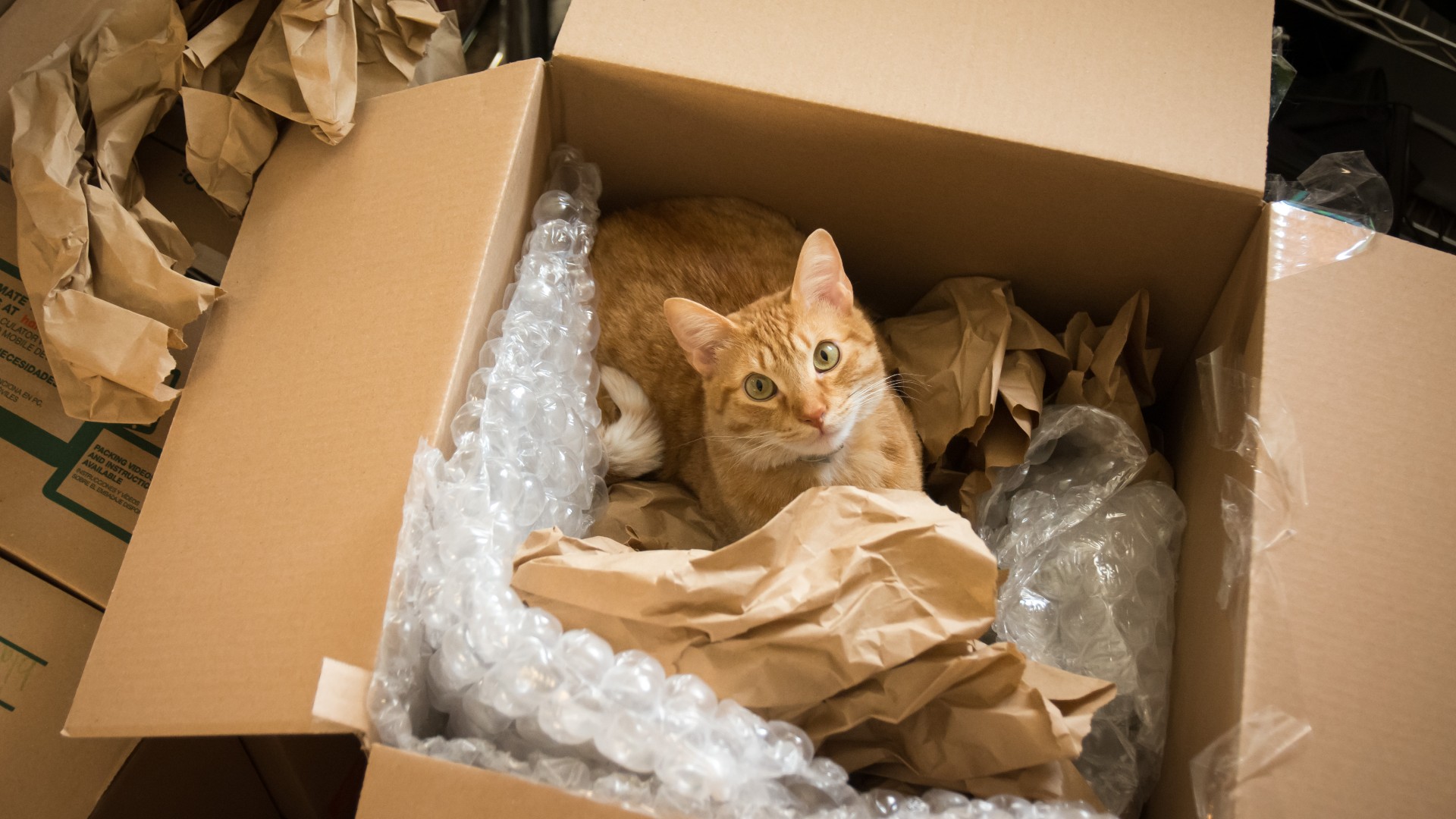How to move house with a cat
Want to know how to move house with a cat? Here's all the tips and tricks you'll need to keep your feline calm and safe

It may seem tough, but if you know how to move house with a cat you can have a relatively stress-free experience for both humans and felines. Moving is already quite stressful, and moving with a cat can add some extra stress - cats are territorial creatures, and they can easily get upended by a change of house. It's a tough situation for them to get accustomed to, but there's plenty that you can do to ensure their transition is as seamless as possible.
You should start prepping your cat for moving house well ahead of moving day. That means getting them used to a change of scenery by starting to pack up some objects, putting their carrier out so they get accustomed to it, and using other calming methods to help make this process go a bit smoother. There are steps you need to take before, during, and after your move to help your cat, and we've got them all detailed here.
So don't fret. While this can be a stressful experience for both cat and cat parent, we’ve got lots of advice here for you to ease you through your next house move, so hopefully everything will be stress-free for everybody involved. Here are the best tips and tricks for how to move house with a cat.
How to move house with a cat: Before the move
Within a few weeks before the move, you should start preparing your home and your cat for what's to come. Here's what you can do.
1. Limit your cat’s movements to just one room at least a few days before your move. Make it as cozy and as warm as possible by including their favorite toys or blanket, and giving them access to a litter tray and fresh water at all times. Keeping them restricted in this way saves them from the hustle, bustle, and chaos of the packing and moving process going on elsewhere, hopefully keeping them as calm as possible. Make sure everybody in your family knows that you’re restricting your cat to one room, and make every effort to keep them inside. It’s worth putting up a sign on the door for movers or cleaners so everyone knows not to disturb them either – it’s a good way to reduce the risk of your cat accidentally escaping, too.
2. Invest in some calming diffusers to help create a general atmosphere of calm at your current house, something which you can also have at your new house to create a sense of continuity. Install these in the weeks leading up to your house move.
3. Keep to your usual routine with your cat as much as possible during this time of change. Where possible, feed them at the same time as usual, let them out at the same time as usual (if you do), and so on. Make sure to reserve some time for play and affection, too. Structure will help keep your cat calm during a time of stress.
Get the best advice, tips and top tech for your beloved Pets
4. Take the time to register with a new vet if you're moving far away before the move so that’s all ready exactly when you might need it.
5. If you’re using a cat carrier to transport your cat (recommended if your new home is even just a few miles away), place the cat carrier in the same room as your cat to get them used to it. They might even take to using it as a bed, and won’t come to associate it with trips to the vet or other less than pleasant experiences.

How to move house with a cat: During the move
1. Before your cat is given unrestricted access at the new place, spend some time giving it a good clean, especially if another cat has been living at the property. Pay attention to areas at 'cat height', such as walls and so on, as this will be where the strongest smells are.
2. Try rubbing a soft cloth on your cat’s face and then rubbing it on furnishings and walls in the new house in order to 'scent transfer' and make the settling in process a lot easier.
3. Unpack as much of your belongings as possible before introducing your cat to the new home, as this will reduce how much you disturb them or scare them. Moving boxes can be loud, and you don't want to freak your cat out any further.
4. Keep your cat restricted to one room for at least a day or two. This will help prevent them from getting overwhelmed by a big, new house. In this room or area, again place all of their things, including a litter tray and bedding, to get them settled in as much as you can first. You can even put a piece of your dirty laundry in there like a sock or a pair of shorts that will give them some familiar smells to comfort them.
5. Check to see how secure your new property is for your cat – look out for any possible escape routes, especially in the garden or outside spaces, as you won’t want to let outdoor cats roam for a while yet.

How to move house with a cat: After the move
It’s important to take things slowly and patiently with your cat after a move. Trying to rush things won’t do anybody any favors, so try as much as you can to be led by your kitty.
1. If it seems like the cat has coped well after a couple of days with just one area of the house, you can start letting them explore other areas. Place multiple items of the cat’s around the house, including several litter trays and bedding.
2. Give them time and space to explore at their own pace, and don’t be too worried or stressed if you find they are a little anxious or start to hide under or in things. They will come out when they’re good and ready, and when they’re feeling more confident about their surroundings.
3. If you have an outdoor space, such as a garden or yard, it’s a good idea to spread some used cat litter around its perimeter to get neighborhood cats used to a new feline in town.
Is it safe to move house with a cat?
It’s worth considering placing your cat into a cattery or perhaps with a trusted friend for the duration of your house move, especially if it’s going to take more than a few hours (for example if it’s a big move across borders). That way, you can make sure all of it takes place without having to worry about your cat getting stressed, going missing, or otherwise getting in the way. It will also allow you prepare the new house fully for their arrival, with the ideas listed above.
Once again, sticking to your cat’s routine is paramount also where possible. Feeding them at the same times once they’ve arrived at the new place and are starting to settle in is really important.
How long does it take for a cat to get used to a new home?
A common question for house movers is how long should you keep cats in when you move. The answer here is at least 2-3 weeks, especially if you’ve moved a considerable distance away – your cat needs plenty of time to create a strong connection to their new home.
Once you’ve waited a while, it’s likely you’ll also want to know how to keep a cat from running away when you move home. Cats have a very strong homing instinct, and if you’ve only moved a few streets away, you might find that they naturally gravitate towards your old place. It's important that you make sure the new owners / occupiers of your former home know your contact information and are aware of your cat just in case.
To help you feel secure that your outdoor cat will return to its new home, you can start small, building up to their usual routine in stages. For example, you can start by letting them out in the garden and going outside with them before returning to the house together. You can then try letting them outside into the garden by themselves, with the door open (if you don’t have a cat flap, or haven’t yet had installed) so they can come and go as they please.
Consider investing in the best microchip cat flap and installing it as soon as you can – this is especially a good idea if the previous owners also had a cat, as the microchip cat flap will stop any other cats apart your own from coming into the house.
Once you’re ready to let your cat out properly, try letting them out just before their typical feeding time – you should find they come back fairly quickly in search of food, giving you both the confidence that they can find their way back.
When making big changes to their environment, like moving house, you might find your cat hiding under the bed.
Amy Davies is a freelance writer and photographer with over 15 years experience. She has a degree in journalism from Cardiff University and has written about a huge variety of topics over the years. These days she mostly specialises in technology and pets, writing across a number of different titles including TechRadar, Stuff, Expert Reviews, T3, Digital Camera World, and of course PetsRadar. She lives in Cardiff with her dog, Lola, a rescue miniature dachshund.

